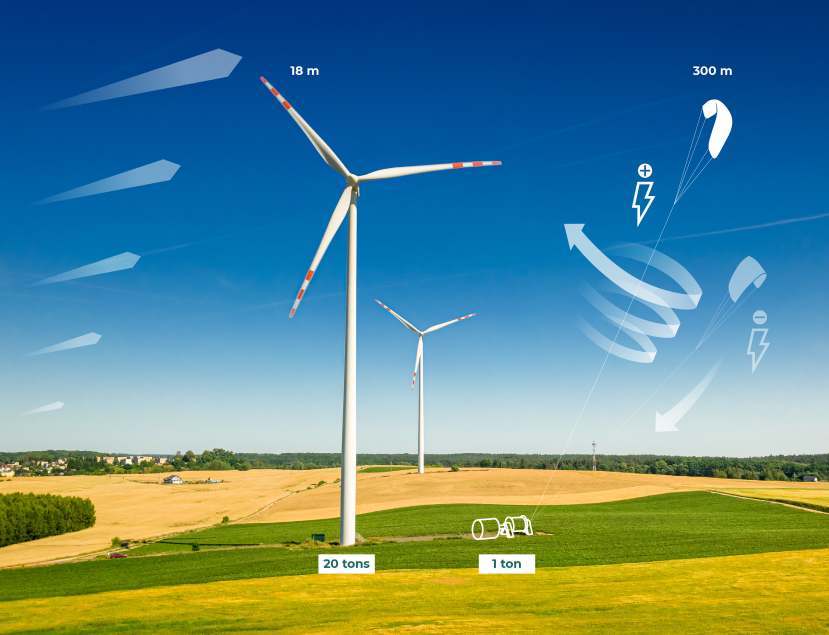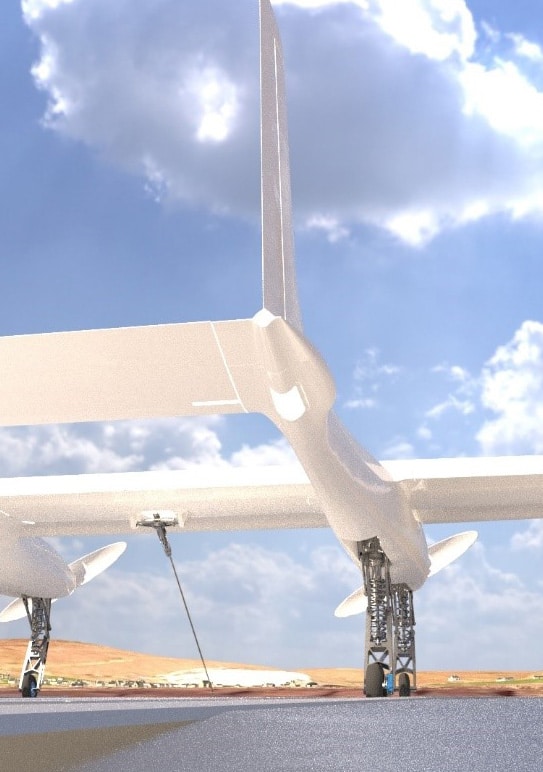Airborne wind energy systems
The hope for a greener future

On the constant search for sustainable energy solutions, Airborne Wind Energy Systems might be the future of renewable energy. But what are they and how do they work? They are colloquially (and a bit incorrectly) known as Kite Power Systems, in reference to the historical craft that inspired it, but with a fundamental difference. They take advantage of the almost uninterrupted availability of high-altitude winds in order to provide a solution that is more flexible than anyother sustainable energy resource exploited to date.
Kites have been around since ancient times, but their potential for producing electrical energy is only recently being harnessed. And because of them, the future of wind energy is looking brighter than ever. These modernday kites can be found in various shapes and materials ranging from wings to hoops, drones, parachutes and even small airplanes. All of them have one thing in common, they convert wind energy into electricity using autonomous tethered flying devices. They are designed for harnessing the power of high-altitude winds that are stronger and more consistent than surface winds; a resource that has never been explored before.
The principle
The idea behind these devices is simple: A kite moving perpendicular to the wind pulls much harder than a stationary kite. And a kite flown in fast loops across the wind can produce enough lift to support itself and generate a useful amount of power, significantly more than a static kite. This principle has sparked research into harnessing wind energy in the most efficient way, deviating from the traditional kite design, and resulting in varying designs of Airborne Wind Energy Systems (AWES) being commercialized today.

AWES fall in one of two types: using on-board turbines with a conducting tether, referred to as “on-board generation”, or converting the pulling power from flying devices on the ground, or “ground generation”. Designs are currently being tested for devices with soft and hard wings, each proposing its own technical challenges. While rigid wings provide more aerodynamic efficiency, soft wings are lighter. Also, in the event of an accident or rough weather conditions, they will create and sustain less damage than its hard wing counterpart.
The system
For on-board generation systems, the basic idea is to deploy small wind turbines at higher altitudes, while ground generation systems rely on the constant spooling and unspooling of the tether. The system functions with continuous spooling cycles consisting of lowtension spooling and high-tension unspooling. The energy required for spooling is only a fraction of the total energy generated. Both are low mass alternatives to their counterparts, the traditional wind turbines, which require very specific conditions and high maintenance for operating at optimal conditions.
While all systems have advantages and drawbacks, AWES have the ability to reach previously inaccessible winds. Material consumption is reduced by as much as 90%, by using a lightweight tether instead of a tower and removing most of the mechanical constraints of the system. This keeps capital costs low. Quick set-up paired with highpower density per km2 can potentially lead to a substantial cost reduction. (cost per kWh).
This makes AWES scalable and deployable to almost anywhere in the world, from remote, mountainous places, to offshore locations where wind is stronger and more consistent, or water too deep to fix a conventional turbine tower to the ocean ground. Systems can produce anywhere from a few kilowatts to several megawatts, making them very attractive for governments, policy makers and industry. They could potentially be paired with other power systems such as Solar Energy Farms, where the kites only cast tiny, transient shadows. AWES exploit a renewable resource that is less dependent on seasonal, regional and environmental factors that can affect energy output.
AWES are designed for automation in order to adjust to changing winds, climate and altitudes depending on location, thus optimizing the conditions for energy harvesting. Because flying systems are generally more complex than wind turbines, there are more possible sources of failure, particularly in launching and landing. In hurricane areas or in case of natural disasters, systems can be secured to avoid damage. Depending on the type of energy generation, parts can even be replaced at relatively low costs without compromising the integrity of the system. The long-term goal is fully automated flying, while simultaneously optimizing the conditions for energy harvesting with reliable sensors, weather prediction models, and proper maintenance.

Challenges
For AWES, the safety zone for operation and flight is set at 300m all around, while danger zones are considered at around a 60m radius from the ground station. This means that the danger zone will only allow for experienced personnel and light transportation while the safety zone excludes busy roads, railways and open water. It is important to understand that all that is known for AWES has been developed from decades of operational experience,but certifications and regulations will affect these criteria while the technology becomes commercially more available. These regulations will be key for establishing safety protocols in avoiding a crash into critical infrastructure, roads, people or entering forbidden airspace. Although impact on wildlife varies per location, the fragmentation and loss of habitat have to be considered along with noise and light pollution in order to determine the true impact on wildlife. However, the most important ecological impact are mortality and disturbance of birds and bats, which is comparable to the impact from conventional wind farms. The limited studies available show that birds can survive impact with the tether and most impacts are not lethal.
A prime example of the possibilities of commercializing AWES is the AP4, a rigid wing, ground generation device developed by Ampyx Power in The Hague, Netherlands. Their goal is to produce a system that can be deployed in markets that are not feasible with current technologies, at a highly competitive cost, while meeting today’s energy demands. They currently operate an off-shore test site in Ireland. In contrast, KitePower BV are developing a soft wing device in the shape of an inflatable kite paired with a ground generation system that makes the whole setup even lighter. The Delft-based company is also currently undertaking research into rigid wing devices in order to study efficiency, optimisation and challenges of both systems. These are both up-and-coming technologies that are already becoming commercially competitive in current renewable energy markets.
Conclusion
Because these devices are still airborne crafts, regulations are yet to be put in place in order to avoid aircrafts colliding with these systems or with foreign objects on the ground. Remaining technical challenges consist of fully automating operations, incorporating new, durable and lightweight but flexible materials capable of sustaining a large number of load cycles. The environmental impact is yet to be assessed per system and location in order to comply with local regulations and minimize the risk of accidents and disturbance on wildlife. As the technology matures, as with any emerging technology, net capacity and the increased power production that comes with material and technological innovation will, in the end, determine the future of Airborne Wind Energy Systems. Still, the drastic reduction in mass paired with the widespread availability of high-altitude winds make them a very attractive investment and a promising alternative for energy generation.